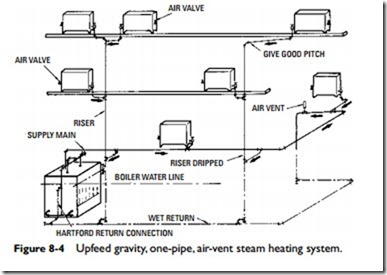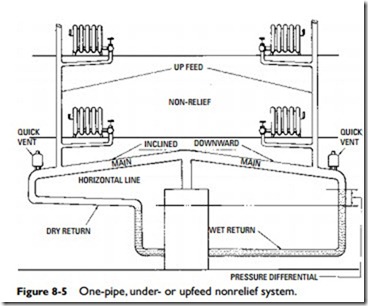Upfeed One-Pipe System
One-pipe steam heating systems can also be of the upfeed type. In a standard upfeed one-pipe steam heating system, both the steam and the condensate travel through the same pipes, and the heat-emitting units are located above the supply mains (hence the name upfeed system).
An attempt to reduce the amount of condensate return in the pipes carrying the steam has resulted in a modification of the upfeed one- pipe system. In the modified system, the condensate is dripped at each radiator (and therefore from the main itself) into a wet return.
The upfeed one-pipe system shown in Figures 8-4 and 8-5 consists of a main or mains branching off from the boiler steam outlet and inclined downward, instead of upward as in the previously described one-pipe system. This arrangement causes the condensate in the mains to flow in the same direction as the steam.
The mains connect with return pipes, which carry all the condensate back to the boiler. It is only in the risers that reverse flow of the condensate takes place, and accordingly they should be large enough to take care of this reverse flow without undue turbulence.
Steam from the boiler flows through the main or mains, accruing condensate with it; the condensate returns (hence the name) to the boiler at a much lower level, as shown in Figures 8-4 and 8-5. After traversing the mains, steam flows through the risers and into the radiators. Condensation takes place as the steam warms the radiators, and the condensate drains through the risers and return pipes to the boiler.
A distinction is made between a wet, or sealed, return and a dry return. A wet return is below the water level in the boiler, whereas a dry return is above the water level. The advantage of a wet return is that it seals and prevents steam at a slightly higher pressure from entering the return. Under most circumstances, a wet return is preferable to a dry return. The latter may be necessary to clear doorways or other openings.
There are no disadvantages to a wet return when the system is properly installed and the valves maintained in tight condition. In most installations, these requirements are often lacking, resulting in many noninherent disadvantages. Among the installation problems that should be avoided are (1) pipes that are too small for the job, (2) sharp turns, (3) air pockets, (4) not enough pitch to the mains, (5) not enough air valves, and (6) air valves that are too small or cheap.

